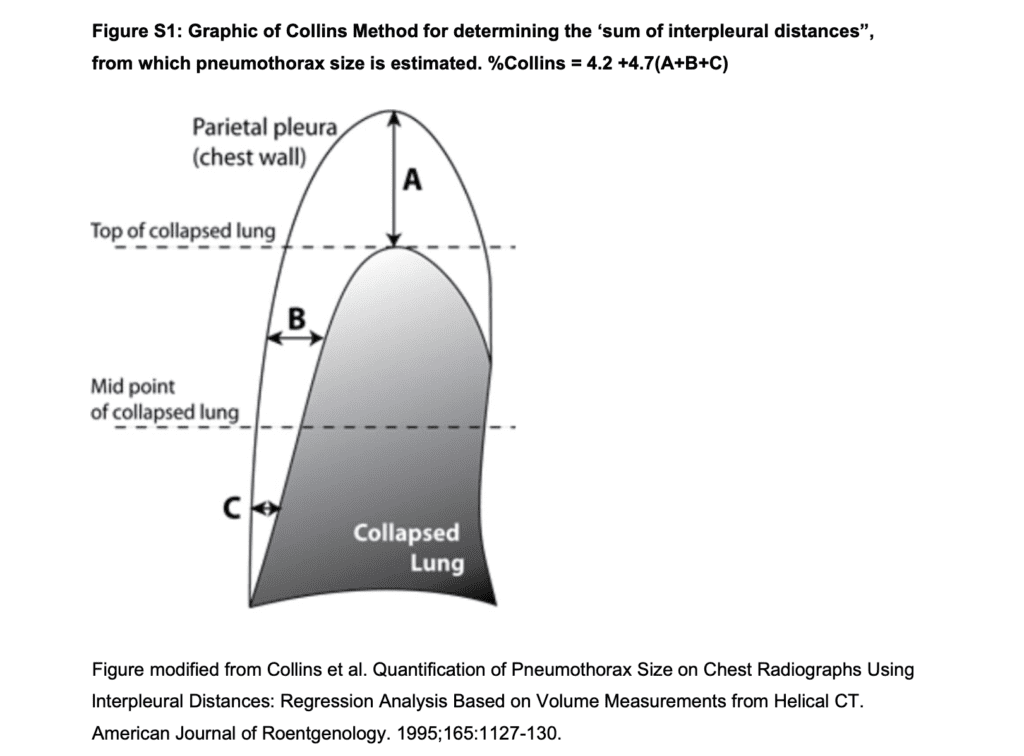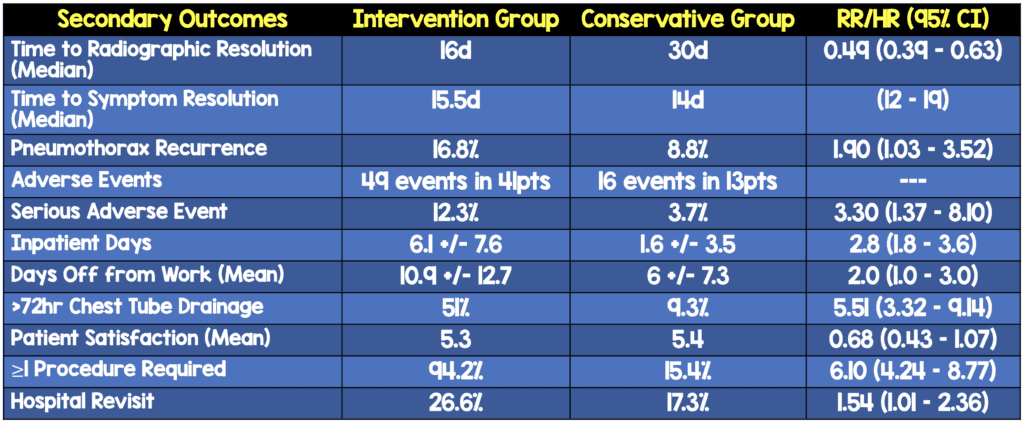
 Background: Most published clinical guidelines on the management of primary spontaneous pneumothorax (PSP) advocate for a conservative approach of observation for small asymptomatic pneumothoraces (PTX).(1,2) However, procedural re-expansion with a catheter or chest tube is recommended for all large pneumothoraces, regardless of symptomatology or clinical stability.(1) More recently, smaller chest tubes (i.e. pigtail catheters) have been used as this can potentially cause less pain. Typically, patients who get chest tubes or pigtail catheters require hospitalization for management of the tube. But, chest tubes are not without risk: there are multiple reports in the literature describing terrible consequences of chest tubes including bleeding, infections and empyemas, and misplacement into vital organs like the liver, spleen, and heart.(3-5) An alternative approach to this invasive procedure is to do nothing, unless the pneumothorax becomes physiologically significant. In an effort to reduce these risks and discomfort to the patient, the clinical quandary becomes: can a large pneumothorax be managed using a conservative observation-only approach, without placement of catheters or chest tubes? To date there have been no randomized clinical trials comparing these two polar opposite management strategies until now (The PSP Trial).
Background: Most published clinical guidelines on the management of primary spontaneous pneumothorax (PSP) advocate for a conservative approach of observation for small asymptomatic pneumothoraces (PTX).(1,2) However, procedural re-expansion with a catheter or chest tube is recommended for all large pneumothoraces, regardless of symptomatology or clinical stability.(1) More recently, smaller chest tubes (i.e. pigtail catheters) have been used as this can potentially cause less pain. Typically, patients who get chest tubes or pigtail catheters require hospitalization for management of the tube. But, chest tubes are not without risk: there are multiple reports in the literature describing terrible consequences of chest tubes including bleeding, infections and empyemas, and misplacement into vital organs like the liver, spleen, and heart.(3-5) An alternative approach to this invasive procedure is to do nothing, unless the pneumothorax becomes physiologically significant. In an effort to reduce these risks and discomfort to the patient, the clinical quandary becomes: can a large pneumothorax be managed using a conservative observation-only approach, without placement of catheters or chest tubes? To date there have been no randomized clinical trials comparing these two polar opposite management strategies until now (The PSP Trial).
Paper: Brown SGA et al. Conservative Versus Interventional Treatment for Spontaneous Pneumothorax. NEJM 2020. PMID: 31995686
Clinical Question: Is conservative management an acceptable alternative to invasive management for uncomplicated, moderate to large primary spontaneous pneumothorax?
What They Did:
- The Primary Spontaneous Pneumothorax trial (PSP Trial)(6)
- Determine if conservative management of PTX >32% has similar rates of lung re-expansion as interventional management (chest tube placement)
- Multicenter, prospective, randomized, noninferiority trial at 39 hospitals in Australia and New Zealand
- All patients received analgesia and supplementary oxygen for saturation <92% on room air
- All patients had in-person, unmasked clinical assessment between 24 & 72hrs after randomization and assessed again at 2-, 4-, and 8-week follow up visits
- Follow up included a chest radiograph and a structured questionnaire regarding symptoms, analgesia use, and patient satisfaction
- Pneumothorax recurrence was assessed at 6 and 12 months after randomization by telephone calls and patient record searches
- Patients were randomized in a 1:1 ratio to either:
- Immediate Interventional Management (Intervention)
- Small bore (≤12 French) Seldinger technique chest tube + underwater seal, without suction
- CXR obtained 1hr later. If lung was re-expanded and underwater drain no longer had a leak, the drain was closed
- CXR obtained 4hrs later. If pts condition had improved and PTX had not recurred, the drain was removed, and patient was discharged
- If pts condition had not improved and PTX had recurred or had not resolved, the underwater seal was opened and patient was admitted to the hospital
- Conservative Observational Management
- Patients observed for >4 hours and repeat radiograph obtained. If ambulatory and not requiring supplementary oxygen, patients were discharged.
- Patients had an intervention if:
- Clinically significant symptoms persisted despite adequate analgesia
- Chest pain or dyspnea prevented mobilization
- The patient was unwilling to continue with conservative treatment
- The patient became unstable (defined as systolic blood pressure of <90 mm Hg, heart rate ≥ to systolic blood pressure, respiratory rate of >30 breaths per minute, or SpO2 of <90% on room air)
- Repeat chest radiograph showed an enlarging PTX along with hemodynamic instability
- Immediate Interventional Management (Intervention)
Outcomes:
- Primary: Lung re-expansion, within 8 weeks
-
Secondary:
- Per-protocol analysis of the primary outcome
- Time to radiographic resolution
- Time to symptom resolution of symptoms (no pain or analgesia use)
- PTX recurrence >24 hours after chest tube removal
- Adverse events
- Length of hospital stay in the first 8 weeks
- Number of invasive procedures
- Number of radiologic investigations
- Number of days off from work
- Chest-tube drainage for >72 hours
- Patient satisfaction
Inclusion Criteria:
- 14-50 year old patients with chest radiograph demonstrating first-episode unilateral spontaneous PTX of >32%, as calculated by the Collins method (7) .
- The Collins method estimates the size of a pneumothorax using a calculation based on measuring the interpleural distance at the apex and the midpoints of the upper and lower halves of the collapsed lung to the hemithorax on a posteroanterior radiograph of the chest.

Exclusion Criteria:
- Previous primary spontaneous PTX on same side
- Bilateral PTX
- Tension PTX (systolic BP <90 mmHg, mean arterial pressure <65 mmHg, or shock index HR/SBP ≥1)
- Secondary PTX (occurring in the setting of trauma or underlying lung disease)
- Concurrent hemothorax
- Pregnancy
- Planned air travel within the following 12 weeks
- Inability to participate in study follow-up
Results:
- 316 patients recruited; data available for 256 patients at 8 weeks
- 154 intervention group patients; data available for 131 at 8 weeks
- 162 conservative group patients; data available for 125 at 8 weeks
- Average age ≈ 26 years
- Mean PTX size ≈ 65% (According to Collins formula)
-
Re-Expansion within 8 Weeks (Primary outcome)
- Intervention group: 129 of 131 (98.5%)
- Conservative group: 118 of 125 (94.4%)
- Risk Difference -4.1%; 95% CI -8.6 to 0.5; p = 0.02 for non-inferiority
- Lower boundary of the 95% CI was within the pre-specified noninferiority margin of -9%
- Re-Expansion within 8 Weeks with Missing Data as Worst-Case Scenario:
- Intervention: 93.5%
- Conservative: 82.5%
- Risk Difference -11.0%; 95% CI -19.4 to -3.5
- Lower boundary of the 95% CI was not within the pre-specified noninferiority margin of -9%
- Secondary outcomes:

Strengths:
- First prospective, randomized study questioning the need for intervention in large PSP
- Multicenter study performed at 39 centers across a spectrum of healthcare settings
- Patients with moderate to large PSPs were included, which is the population most physicians would want to intervene on
- Performed a sensitivity analysis in which all missing data after 56 days was imputed as treatment failure (i.e. worst-case scenario)
- Many secondary outcomes investigating endpoints that are important to both clinicians and patients in making decisions regarding management strategies
Limitations:
- Protocol for intervention in this study is different from most published guidelines and clinical practice
- This was an unblinded study. Patients and physicians obviously knew what was being done, and this could bias the results. For example, treating clinicians were more likely than independent radiologists (who were blinded) to report full radiographic resolution in the group receiving interventional management which biases the primary outcome findings in favor of the interventional treatment
- A non-inferiority bound of 9% represents a relatively large margin for a noninferiority trial. As there was no previously established noninferiority margin, a steering committee of respiratory and emergency physicians reasoned that a success rate of 90% in the conservative management group as compared with an anticipated 99% success rate in the intervention group after 8 weeks would be acceptable. This means 1 in 10 patients would have failure of conservative management
- This is a very specific patient population as >2600 patients were assessed for eligibility and only 316 patients underwent randomization. Conservative management will not apply to everyone with a PTX.
- Significant number of patients in the conservative management group (25pts = 15.4%) underwent interventions to manage the PTX (The reason for this was pre-specified in the protocol)
- 90 patients were lost to follow up, did not have data available on symptom resolution, and/or did not undergo confirmatory CXR. This is 28.5% of the randomized patients (i.e. We have no idea what the outcomes were in these patients)
- Despite multiple secondary outcomes favoring the conservative management group, these should be considered hypothesis generating as they are not adjusted for multiple comparisons
- Data is presented in a variety of ways to accommodate and include patients that were randomized but failed to complete the pre-determined protocol (ie data unavailable at or prior to the 8-week point)
Discussion:
Conservative management of relatively small pneumothorax in the medical and trauma literature has been studied and is practiced clinically. (1,2,8,9) As a noninferiority trial, the purpose of the study was to compare whether conservative management (no chest tube placement) is not worse than placing a chest tube in patients with >32% spontaneous PTX and it succeeded in doing so. Not only did patients in the conservative management group NOT fare worse than the “standard-of-care,” chest tube placement, but they also had fewer adverse events, fewer hospitalization days, fewer days off work, less radiographic imaging, and fewer subsequent interventions. Interestingly, patients in the conservative management group also had less recurrence rates than the intervention group. As the accompanying editorial posits, chest-tube drainage may have interfered with healing by pulling open the defect in the lung causing a slow leak, whereas slow lung re-expansion may have permitted the defect to heal more fully.(10) Of note, patient satisfaction scores did not differ between the 2 groups, which is surprising as one would presume that an approach that spares the patient a painful procedure would result in higher patient satisfaction.
Author Conclusion:
“Although the primary outcome was not statistically robust to conservative assumptions about missing data, the trial provides modest evidence that conservative management of primary spontaneous pneumothorax was noninferior to interventional management, with a lower risk of serious adverse events.”
Clinical Take Home Point:
In a select and carefully identified subset of patients with large primary spontaneous pneumothorax in a clinical setting that can accommodate both observation and potential emergent intervention, a conservative management approach of observation may obviate the need for chest tubes. For many clinicians, this strategy may not be feasible. The authors of this trial have posed a critical question and laid the foundation for a shift in the management of larger primary spontaneous pneumothoraces.
References:
- Baumann MH, et al. Management of spontaneous pneumothorax: an American College of Chest Physicians Delphi consensus statement. Chest 2001;119(2):590‐602. PMID: 11171742
- MacDuff A 2010 BTS Pleural Disease Guideline Group. Management of spontaneous pneumothorax: British Thoracic Society Pleural Disease Guideline. Thorax. 2010 Aug;65 Suppl 2:ii18-31. PMID: 20696690
- Gorospe L, et al. A malpositioned chest tube within the liver. Asian Cardiovasc Thorac Ann. 2016 Jul;24(6):612 PMID:25834127
- Ohtaka K,et al. Noninvasive management for iatrogenic splenic injury caused by chest tube insertion: a case report. Clin Case Rep. 2016 Oct 28;4(12):1157-1160. PMID: 27980753
- Shin-Kim J, Zapolsky N, Wan E, Steinberg E, Heller M, Jacoby JL. Left ventricular perforation with catheter decompression. Am J Emerg Med. 2019 Feb;37(2):377.e5-377.e6.PMID: 30413368
- Brown SGA, et al. Conservative versus Interventional Treatment for Spontaneous Pneumothorax. N Engl J Med. 2020 January:405-415. PMID: 31995686
- Collins CD, et al. Quantification of pneumothorax size on chest radiographs using interpleural distances: regression analysis based on volume measurements from helical CT. Am J Roentgenol. 1995 Nov;165(5):1127-30. PMID: 7572489
- Bou Zein Eddine S, et al. Observing pneumothoraces: The 35-millimeter rule is safe for both blunt and penetrating chest trauma. J Trauma Acute Care Surg. 2019 Apr;86(4):557-564. PMID: 30629009
- Walker SP, Barratt SL, Thompson J, Maskell NA. Conservative Management in Traumatic Pneumothoraces: An Observational Study. Chest. 2018 Apr;153(4):946-953. PMID: 29080710
- Broaddus VC. Clearing the Air – A Conservative Option for Spontaneous Pneumothorax. N Engl J Med. 2020 Jan 30;382(5):469-470. PMID: 31995695
For More Thoughts on This Topic Checkout:
- Emlyn’s Blog: JC – Conservative Management of Pneumothoraces
- EM Lit of Note: Put an End to Routine Chest Tubes
- First10EM: Conservative Treatment for Primary Spontaneous Pneumothorax
- The Bottom Line: Primary Spontaneous Pneumothorax (PSP) Trial
- The SGEM: SGEM #300 – The Lung is Up Where it Belongs – With or Without a Chest Tube
Post Peer Reviewed By: Salim R. Rezaie, MD (Twitter: @srrezaie)
The post Spontaneous Pneumothorax: Stand There and Do Nothing? appeared first on REBEL EM - Emergency Medicine Blog.
